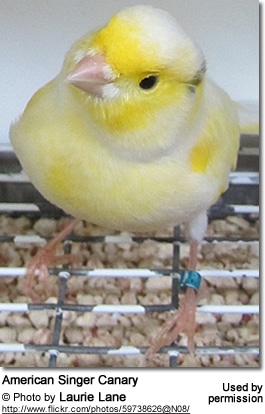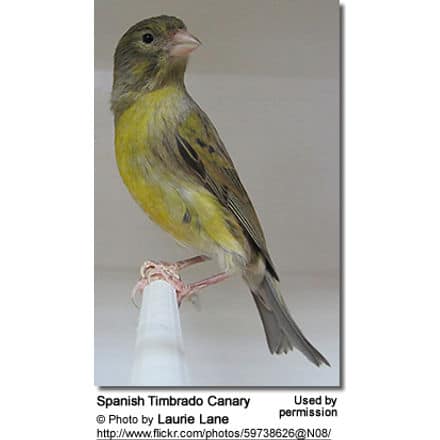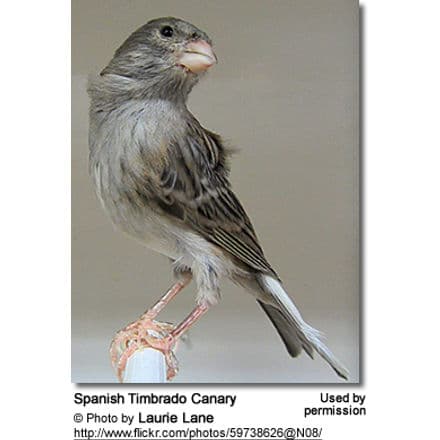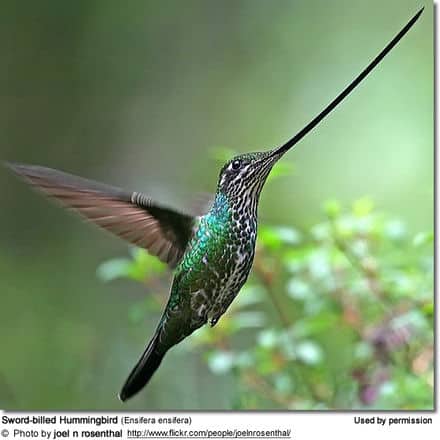Song Canaries
Song Canaries: Information and Sound Recordings
Canary Information: General Care and Housing
Song canaries are bred for their unique and specific song patterns. The natural talents gained through their genetic make-up can be further enhanced through training. Song canaries can learn to imitate a variety of songs and sounds that they hear again and again in their environment. (Please refer to the training video at the bottom of this page).

Several breeds are available that produce different types of songs / sounds.
Reasons Why Song Canaries Don’t Sing
Basic Types of Song Canaries
- Choppers (Border, Norwich, Yorkshire and Fife Fancy canaries) sing loud, choppy song notes with their beaks wide open – often bred for “type” (size, color and disposition)
- Rollers (Roller Canaries) produce a softer, lower tune melody in which their beak remain shut or just barely opens.
- Warblers (Red Factor and Hartz Mountain canaries) produce a combination of songs.
- American Singers produce both chops and rolls.
Breeds of Song Canaries
German Roller Canary German Harzer Roller
- Best known for the hollow rolling tours
- Sing with their beak closed
Belgian Waterslager / Belgian Malinois Waterslager aka Belgium Waterslager Song Canary, Waterslager Song Canary, Malinois Canary or Water Singer.
- Closest relative to the Roller. Song is always soft and bubbly akin to the sound of rolling water with some notes sounding like water dripping into a barrel. Of all song canaries, these produce the lowest and highest range of notes and without any harsh chopping sounds.
- They sing with their beak closed, except for opening their beaks for some pronounced sounds.
- Averages a length of about 5 inches or 13 cm. Produce chattering sounds and metallic tones. Their pleasant songs are considered to be the loudest of all canary songs. Both males and females sing; however, the male is more likely to produce a full song.

Song Canaries that are not currently recognized by the World Ornithological Confederation (C.O.M.):
- An American combination of 2/3 German Harzer Roller canary known for its beautiful song and 1/3 Border canary known for its attractive appearance. Bred in a wide variety of colors.
- Its song is a combination of the Roller and the Border Canaries.
Russian Singer Canary
- This smaller canary is a talented mimic with an intricate, artful song.
Persian Singer Canary
Many people keep canaries for their song. But what if they don’t sing?
Their song is stimulated by movements, therefore, keep your canary in a room your family occupies frequently (or in an aviary with other birds).
Are you sure your canary is a male? Frequently, hens are being sold as males, as it is difficult to sex them when they are young. The beautiful song of the male only develop as they mature. Many females do sing quite well, but lack the long trills and warbles of the male. Talented males and females can learn to mimic sound — so much so that with a little training, a female’s song can’t be distinguished from that of a male canary.
Is your canary molting? Canaries don’t sing during this time. Canaries molt (change plumage) once a year – usually during the summer. A molt should take no longer than 6 to 8 weeks. If it takes longer, then a vet should be consulted as your canary could suffer from a feather disorder. Since molting can be stressful and uncomfortable, some birds experience a decrease in appetite. However, an increase in metabolism to accommodate the production of several thousand new feathers can cause an increase in appetite. Whether they lose their appetite or eat more during the molt probably depends on their comfort level. Molting birds benefit from more quality protein in the diet which can be provided in the form of well done eggs, well cooked meats and seafood, as well as cooked beans and rice, which together form a complete protein. Additional protein and good fats are needed to create strong and lustrous feathers. This is a good time to grind and sprinkle flax seeds over the birds’ food. Hemp seeds also provide beneficial oils and the essential fatty acids (EFAs) necessary to produce quality feathers. (*Hemp Seeds are often referred to as “super-seeds” as they offer a complete amino acid profile, have an ideal balance of omega 3 and 6 fatty acids, and provide an impressive amount of trace minerals – they also have the highest concentration of protein in the plant kingdom.)
How is your canary’s diet? Is the diet appropriate for the canary? Do you provide a quality canary seed, fresh fruits and veggies / greens; calcium / mineral and vitamin supplements? The basic, cheap seed mix at your local grocery store is not going to keep your canary in good health and singing. Feedering your canary for optimal health.
Is your canary sick? Is your canary protected from draft? Is he or she lively and social, or fluffed up and sleepy. A sick canary won’t sing. If there is reason for concern, a vet should be consulted.
Species Research by Sibylle Johnson
Please Note: The articles or images on this page are the sole property of the authors or photographers. Please contact them directly with respect to any copyright or licensing questions. Thank you.



